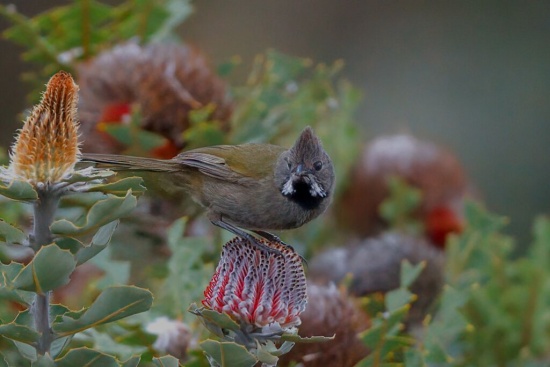
Cheynes Beach, Waychinicup National Park, Western Australia, 19 September 2020
Alternative names: Black-throated Whipbird; Coachwhip-bird
- Psophodes nigrogularis
Includes Mallee Whipbird
Identification
19-25.5cm.
- Grey head and crest
- Pale olive upperparts
- Black throat
- White cheek stripes, edged with black (fully in nigrogularis, only partly in leucogaster)
- Long dark olive-green tail tipped with white
- Pale olive underparts
- Black bill and feet
Sexes similar. Juveniles are a duller olive-brown in colour and lack the white cheek stripes and dark throat.
Similar Species
Distribution
Locally in south west and southern Australia.
Restricted-range species. Considered near-threatened as range has contracted owing to habitat clearance.
Taxonomy
Subspecies
Clements recognises four subspecies[1]:
- P. n. nigrogularis at Two Peoples Bay in southern Western Australia
- P. n. oberon in the mallee heaths of southwest Western Australia
- P. n. leucogaster on the Yorke Peninsula and Murray Mallee in southeast South Australia and northwest Victoria
- P. n. lashmari on Kangaroo Island
Leucogaster, lashmari and oberon are split by some authorities and named Mallee Whipbird, Psophodes leucogaster.
Habitat
Mallee eucalyptus, heath, shrubland or acacia vegetation, often near coasts.
Behaviour
Shy and elusive.
Diet
They feed by foraging on the ground for invertebrates. The diet includes caterpillars, ants and beetles, as well as spiders.
Breeding
Breeding season from July to October. They build a cup-shaped nest out of twigs, bark, grass and other vegetation in a dense shrub close to the ground; 2 pale blue eggs are laid.
Movements
Resident species.
References
- Clements, J. F., T. S. Schulenberg, M. J. Iliff, S. M. Billerman, T. A. Fredericks, B. L. Sullivan, and C. L. Wood. 2019. The eBird/Clements Checklist of Birds of the World: v2019. Downloaded from http://www.birds.cornell.edu/clementschecklist/download/
- Del Hoyo, J, A Elliott, and D Christie, eds. 2007. Handbook of the Birds of the World. Volume 12: Picathartes to Tits and Chickadees. Barcelona: Lynx Edicions. ISBN 978-8496553422
- Simpson, K and N Day. 1998. Field Guide to the Birds of Australia. London: Christopher Helm. ISBN 0-7136-4877-5
Recommended Citation
- BirdForum Opus contributors. (2024) Western Whipbird. In: BirdForum, the forum for wild birds and birding. Retrieved 27 April 2024 from https://www.birdforum.net/opus/Western_Whipbird
External Links
GSearch checked for 2020 platform.1



